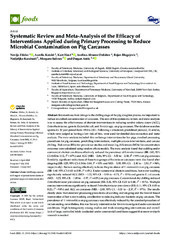Приказ основних података о документу
Systematic Review and Meta-Analysis of the Efficacy of Interventions Applied during Primary Processing to Reduce Microbial Contamination on Pig Carcasses
| dc.creator | Zdolec, Nevijo | |
| dc.creator | Kotsiri, Aurelia | |
| dc.creator | Houf, Kurt | |
| dc.creator | Alvarez-Ordóñez, Avelino | |
| dc.creator | Blagojević, Bojan | |
| dc.creator | Karabasil, Nedjeljko | |
| dc.creator | Salines, Morgane | |
| dc.creator | Antić, Dragan | |
| dc.date.accessioned | 2022-11-15T09:26:57Z | |
| dc.date.available | 2022-11-15T09:26:57Z | |
| dc.date.issued | 2022 | |
| dc.identifier.issn | 2304-8158 | |
| dc.identifier.uri | https://vet-erinar.vet.bg.ac.rs/handle/123456789/2497 | |
| dc.description.abstract | Interventions from lairage to the chilling stage of the pig slaughter process are important to reduce microbial contamination of carcasses. The aim of this systematic review and meta-analysis was to assess the effectiveness of abattoir interventions in reducing aerobic colony count (ACC), Enterobacteriaceae, generic Escherichia coli, and Yersinia spp. on pig carcasses. The database searches spanned a 30 year period from 1990 to 2021. Following a structured, predefined protocol, 22 articles, which were judged as having a low risk of bias, were used for detailed data extraction and meta-analysis. The meta-analysis included data on lairage interventions for live pigs, standard processing procedures for pig carcasses, prechilling interventions, multiple carcass interventions, and carcass chilling. Risk ratios (RRs) for prevalence studies and mean log differences (MDs) for concentration outcomes were calculated using random effects models. The meta-analysis found that scalding under commercial abattoir conditions effectively reduced the prevalence of Enterobacteriaceae (RR: 0.05, 95% CI: 0.02 to 0.12, I2 = 87%) and ACC (MD: −2.84, 95% CI: −3.50 to −2.18, I2 = 99%) on pig carcasses. Similarly, significant reductions of these two groups of bacteria on carcasses were also found after singeing (RR: 0.25, 95% CI: 0.14 to 0.44, I2 = 90% and MD: −1.95, 95% CI: −2.40 to −1.50, I2 = 96%, respectively). Rectum sealing effectively reduces the prevalence of Y. enterocolitica on pig carcasses (RR: 0.60, 95% CI: 0.41 to 0.89, I2 = 0%). Under commercial abattoir conditions, hot water washing significantly reduced ACC (MD: −1.32, 95% CI: −1.93 to −0.71, I2 = 93%) and generic E. coli counts (MD: −1.23, 95% CI: −1.89 to −0.57, I2 = 61%) on pig carcasses. Conventional dry chilling reduced Enterobacteriaceae prevalence on pig carcasses (RR: 0.32, 95% CI: 0.21 to 0.48, I2 = 81%). Multiple carcass interventions significantly reduced Enterobacteriaceae prevalence (RR: 0.11, 95% CI: 0.05 to 0.23, I2 = 94%) and ACC on carcasses (MD: −2.85, 95% CI: −3.33 to −2.37, I2 = 97%). The results clearly show that standard processing procedures of scalding and singeing and the hazard-based intervention of hot water washing are effective in reducing indicator bacteria on pig carcasses. The prevalence of Y. enterocolitica on pig carcasses was effectively reduced by the standard procedure of rectum sealing; nevertheless, this was the only intervention for Yersinia investigated under commercial conditions. High heterogeneity among studies and trials investigating interventions and overall lack of large, controlled trials conducted under commercial conditions suggest that more in-depth research is needed. | |
| dc.language | en | |
| dc.publisher | MDPI | |
| dc.relation | COST Action 18105 (Risk-based Meat Inspection and Integrated Meat Safety Assurance | |
| dc.relation.isreferencedby | https://vet-erinar.vet.bg.ac.rs/handle/123456789/2498 | |
| dc.rights | openAccess | |
| dc.rights.uri | https://creativecommons.org/licenses/by/4.0/ | |
| dc.source | Foods | |
| dc.subject | Enterobacteriaceae | |
| dc.subject | Yersinia | |
| dc.subject | abattoir | |
| dc.subject | aerobic colony count | |
| dc.subject | chilling | |
| dc.subject | generic E. coli | |
| dc.subject | hot water washing | |
| dc.subject | interventions | |
| dc.subject | pig carcasses | |
| dc.title | Systematic Review and Meta-Analysis of the Efficacy of Interventions Applied during Primary Processing to Reduce Microbial Contamination on Pig Carcasses | |
| dc.type | article | en |
| dc.rights.license | BY | |
| dc.citation.volume | 11 | |
| dc.citation.issue | 14 | |
| dc.citation.spage | 2110 | |
| dc.citation.rank | M21~ | |
| dc.description.other | Supplementary material: [https://vet-erinar.vet.bg.ac.rs/handle/123456789/2498] | |
| dc.identifier.wos | 00083381410000 | |
| dc.identifier.doi | 10.3390/foods11142110 | |
| dc.identifier.pmid | 35885353 | |
| dc.identifier.scopus | 2-s2.0-85136185528 | |
| dc.identifier.fulltext | http://veterinar.vet.bg.ac.rs/bitstream/id/7158/foods-11-02110.pdf | |
| dc.type.version | publishedVersion |

